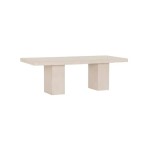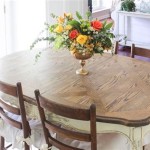The Enduring Appeal of the Round Oak Dining Table: A Guide to Antique Examples
Round oak dining tables have held a significant place in furniture history, particularly during the late 19th and early 20th centuries. Their popularity stemmed from a combination of factors, including the accessibility of oak as a material, the versatility of a round shape for social interaction, and evolving design trends that favored functionality and aesthetic appeal. Antique round oak dining tables today are not merely pieces of furniture; they represent a tangible connection to a bygone era, reflecting the craftsmanship, social customs, and design sensibilities of their time. Understanding the characteristics, history, and valuation of these tables is crucial for collectors, enthusiasts, and anyone seeking to own a piece of history.
The rise of oak as a preferred material for furniture production can be directly linked to the Industrial Revolution. Advancements in sawmilling technology made it easier and more cost-effective to process large quantities of oak lumber. Furthermore, the burgeoning middle class desired durable and aesthetically pleasing furniture that was within their financial reach. Oak, with its inherent strength, readily available supply, and attractive grain patterns, fulfilled these requirements perfectly. As a result, oak became a staple in the production of a wide range of furniture, including dining tables.
The round shape of these tables also contributed to their widespread adoption. Unlike rectangular tables, which often create a hierarchical seating arrangement with designated “head” and “foot” positions, round tables promote equality and inclusivity. Everyone seated around the table is visually and conversationally connected, facilitating a more harmonious and engaging dining experience. This feature was particularly appealing in a time that emphasized family values and social gatherings. The absence of sharp corners also made them practical for smaller dining rooms, a common feature in many homes of the era.
Key Characteristics of Antique Round Oak Dining Tables
Identifying an antique round oak dining table requires careful examination of several key characteristics. These include the type of oak used, the style of the base and legs, the presence and type of leaves, and any distinctive hardware or decorative elements. Understanding these features allows for a more accurate assessment of age, origin, and authenticity.
Different species of oak were commonly used in antique furniture production. Quarter-sawn oak, prized for its distinctive ray flecks and exceptional stability, was a popular choice for high-quality tables. The quarter-sawing process, which involves cutting the log at a specific angle, reveals the medullary rays, resulting in a visually striking grain pattern. Plain-sawn oak, while less expensive, was also used, offering a different aesthetic with its more straightforward grain. Identifying the type of oak is crucial for determining the table's overall value and potential durability.
The base and legs of an antique round oak dining table offer valuable clues about its style and period. Common styles include pedestal bases, often featuring ornate carvings and claw feet, and splayed legs, which provide stability and visual interest. The style of the legs can range from simple and utilitarian to highly decorative, reflecting prevailing design trends of the time. The joinery techniques used to connect the legs to the tabletop are also important indicators of quality and craftsmanship. Look for mortise-and-tenon joints, dovetail joints, and other traditional woodworking methods that signify a higher level of skill and attention to detail.
Many antique round oak dining tables were designed with leaves to accommodate larger gatherings. These leaves could be either drop-leaf extensions that fold down from the sides of the table or separate leaves that insert into the center. The presence and condition of the leaves are essential factors in determining the table's overall value. Matching leaves, which feature the same grain patterns and finish as the tabletop, are particularly desirable. The mechanisms used to extend and support the leaves can also reveal clues about the table's age and origin. Look for geared mechanisms or simpler sliding mechanisms, which were common in different periods.
Dating and Origin of Antique Round Oak Dining Tables
Determining the age and origin of an antique round oak dining table involves analyzing various factors, including stylistic details, manufacturing techniques, and historical context. Furniture styles evolved over time, reflecting changing tastes and social trends. By identifying the stylistic characteristics of the table, one can narrow down its potential period of origin.
The late Victorian era (roughly 1837-1901) saw a surge in the popularity of round oak dining tables. These tables often featured heavy proportions, ornate carvings, and dark finishes. Common decorative motifs included floral patterns, scrollwork, and claw feet. The use of quarter-sawn oak was prevalent, and the tables were typically constructed with solid, durable materials. Tables from this era often reflect the Victorian emphasis on grandeur and opulence.
The early 20th century, particularly the Arts and Crafts movement (roughly 1880-1920), brought a shift towards simpler, more functional designs. Round oak dining tables from this period often featured clean lines, minimal ornamentation, and lighter finishes. The emphasis was on showcasing the natural beauty of the wood and celebrating handcrafted details. Stickley and other prominent Arts and Crafts furniture makers produced round oak dining tables that are highly sought after by collectors today.
The Art Deco period (roughly 1920-1939) introduced new design influences, incorporating geometric shapes, streamlined forms, and exotic materials. While oak remained a popular choice, tables from this era often featured contrasting veneers, inlaid details, and chrome accents. The round shape continued to be favored, but the overall aesthetic became more modern and sophisticated.
Identifying the manufacturer of an antique round oak dining table can greatly enhance its value and historical significance. Some tables may bear a maker's mark or label, providing direct evidence of their origin. However, many tables were not explicitly marked, requiring further research to determine their provenance. Consulting furniture catalogs, historical records, and expert appraisals can help to identify the manufacturer and trace the table's history.
Preservation and Restoration of Antique Round Oak Dining Tables
Preserving and restoring an antique round oak dining table requires a careful and considered approach. The goal should be to maintain the table's historical integrity while addressing any structural or cosmetic issues. Proper cleaning, repair, and refinishing techniques are essential for ensuring the longevity and value of the piece.
Cleaning an antique round oak dining table should be done gently and with appropriate materials. Avoid harsh chemicals or abrasive cleaners, which can damage the finish and wood. A soft, damp cloth can be used to remove dust and grime. For more stubborn stains, a mild soap solution can be applied sparingly, followed by a thorough rinsing with clean water. Always dry the table immediately after cleaning to prevent water damage.
Repairing structural damage, such as loose joints or cracked legs, should be entrusted to a qualified furniture restorer. Attempting to repair these issues without the necessary skills and tools can cause further damage. A skilled restorer will use traditional woodworking techniques to reinforce the joints and repair any cracks, ensuring the table's stability and functionality.
Refinishing an antique round oak dining table is a complex process that requires careful consideration. Removing the old finish can reveal the original wood and allow for a fresh coat of varnish or lacquer. However, refinishing can also diminish the table's historical value if not done properly. It's important to choose a finish that is appropriate for the table's age and style. Consider consulting with a professional restorer to determine the best course of action.
Maintaining the finish of an antique round oak dining table is crucial for preserving its beauty and protecting the wood. Regular polishing with a high-quality furniture polish can help to prevent scratches and watermarks. Avoid placing hot dishes or wet glasses directly on the table's surface. Use coasters and placemats to protect the finish from damage.
Ultimately, the decision to restore or preserve an antique round oak dining table depends on individual preferences and the table's condition. Some collectors prefer to maintain the table in its original, unrestored state, valuing the patina of age and the evidence of its history. Others may opt for a full restoration to bring the table back to its original glory. Whatever the choice, it's important to approach the process with respect for the table's history and significance.

Antique Round Dining Table In Oak 1870s

Antique Round Tiger Oak Dining Table In Days Of Olde

Antique Round Tiger Oak Dining Table In Days Of Olde

Amish 48 Round Christeen Single Pedestal Table

Save 20 Victorian Antique 54 Round Oak Table 5 Leaves Hastings

Antique Oak Mission Style Pedestal Round Dining Table With Leaf

Arch Pedestal Round Oak Dining Table Antique Farmhouse

Antique Round Dining Table In Oak 1870s

Antique American Victorian Era Renaissance Revival Carved Oak Split Pedestal Extension Round Dining Table With Figural Dolphin Fish Carving Etsy

Best Master Furniture Venus 48 Round Wood Dinette Table In Antique Natural Oak








